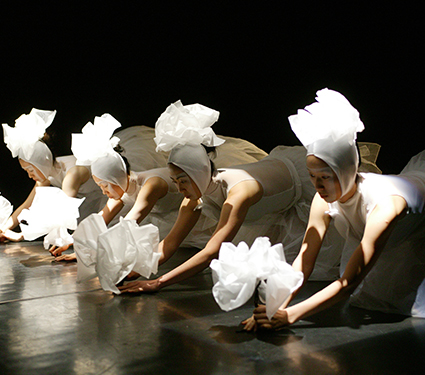One of the more visually stunning moments of the performance occurs in the second act when the performers use a large carpet to shower the stage with paper confetti. (Courtesy KMP Artists)
By Cameron Wisdom | Editor-in-Chief
The Haugh Performing Arts Center recently hosted the SEOP Dance Company’s dance composition “A Man’s Requiem”, which provoked the senses of sight and sound in a stunning display of traditional and modern Korean dance techniques.
The 107 minute performance captivated the audience with its symbolic interpretation of death in relation to Korean belief systems rooted in Buddhism and Christianity.
According to the dance company’s interpretation, the composition explores the powerful theme of “when a sinner dies he must be judged.”
Kim Yong Chul, Ph. D., a famous South Korean performer and choreographer, composed the requiem. Chul and his company have toured nine countries performing the dance.
The performance is divided into four acts narrating the story of one man’s death and the journey through the afterlife.
The performance begins with a figure representing the living spirit of the protagonist symbolically dancing to the rhythm of traditional South Korean folk music.
The first act was purposefully eerie. Playing the menacing messenger of death, Chul lurks in the shadows during the early minutes of the production.
His presence amplifies the tension building in the room as he eerily creeps out of the darkness to deliver the protagonist to the afterlife.
The second act is filled with ethereal sounds and vivid imagery of enlightenment. Chul’s company upped the visual ante with symbolic stagecraft to set the scene of the protagonist passing over.

One notable scene during the second act consisted of a troupe of female dancers collectively scrunching sheets of tissue paper in slightly imperfect unison for an extended amount of time.
The room was deafly silent, so much so in fact that it amplified the singular sound of the paper being carefully twisted.
Anxiety continues to heighten throughout the performance, and the company makes extensive display of their choreographic prowess throughout.
The minimalist stage and prop design nearly stole the show. It created the ambiance of religious interpretations of the soul’s journey after death. There was never a moment where the items on stage seemed out of place or unnecessary. Every piece lent itself as a vehicle to advance the story.
At times the score was cryptic, at others enlightening. The rhythm and cadence of each piece controlled the pace of the performers on movement with soulful exuberance.
Some of the darker pieces seemed to mimic the pulse of a tensely beating heart.
Traditional South Korean music was heavily featured, and there were moments where seemingly inhuman sounds permeated throughout the room.
Traditional South Korean folk music is heavily featured throughout, keeping with the show’s roots and overarching theme.
The quality of the production is a testament to the Haugh’s ability to attract world-renowned acts and performances to the Citrus community.
Audience members were awestruck by the world-class dancers who were able to tell a vivid story without the spoken word.
In all, this performance was as captivating as it was visually and audibly stunning. Those in attendance were exposed to exotic cultural dances and otherworldly perspectives, and their final ovation spoke volumes about it’s impact.


